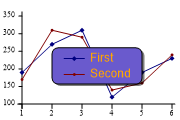| Automated charting and reporting |
SharpPlot Tutorials
General Tutorials
Chart Samples
Style Examples
SharpLeaf Tutorials
Document Layout Tutorials
Text Flow Tutorials
Table Tutorials
Visual Glossaries
SharpPlot Class
SharpPlot Properties
SharpPlot Structures
SharpPlot Enumerations
PageMap Class
SharpLeaf Reference
SharpLeaf Class
SharpLeaf Properties
SharpLeaf Methods
Table Class
Table Properties
Table Methods
SharpLeaf Structures
FontType Structure
ParagraphStyle Structure
BoxStyle Structure
SharpLeaf Enumerations
DocumentLayout Classes
DocumentLayout Class
PageLayout Class
PageElement Abstract Class
Frame : PageElement Class
TextBlock : PageElement Class
ImageBlock : PageElement Class
Box : PageElement Class
Rule : PageElement Class
Common Reference
Document Class
VectorMath Class
DbUtil Class
Download
Release Notes
Licensing
SharpPlot Reference > SharpPlot Methods > DrawKey Method
SharpPlot.DrawKey Method
This will draw and clear any pending keys, using the current setting of key text. It is called automatically on Rendering the completed chart, so is only required if you need an exact key location or a custom-designed key. Use the KeyLimit property to restrict the number of items used at each call. Use the SetKeyIndices method for finer control over key selection and order.
Example
sp.KeyStyle = KeyStyles.Boxed|KeyStyles.Vertical|KeyStyles.Shadowed|KeyStyles.Rounded; sp.SetKeyBackground(Color.SlateBlue,FillStyle.Solid); sp.SetKeyFont("Arial,sans",12,FontStyle.Bold,Color.Orange); sp.SetKeyText(new string[]{"First","Second"}); sp.DrawKey(2,260);
Overloads
- public void DrawKey();
- public void DrawKey(KeyDefinition keyDefinition);
- public void DrawKey(KeyDefinition[] keyDefinition);
- public void DrawKey(double keyPositionX,double keyPositionY,KeyDefinition keyDefinition);
- public void DrawKey(double keyPositionX,double keyPositionY);
- public void DrawKey(double keyPositionX,double keyPositionY,KeyDefinition[] keyDefinition);
Description
The chart Key or Legend consists of small placeholders for each line or filled area (appropriately coloured and styled) with an item of descriptive text for each. When any of the Draw methods is called to create a chart (you may call these repeatedly with various series to reuse the same set of axes) a placeholder is stored away to represent all the series plotted on that call. When the chart is rendered, DrawKey is called automatically to check if any KeyText has been set for the various series. If so, a placeholder and associated text are drawn as specified in the KeyStyle setting.
This method may be used to position the key ‘by hand’ anywhere in the chart area instead of at one of the many default locations which may be given in the style. It should always be called after all the charts have been drawn, otherwise the key placeholders will not be available for all the data series.
It is possible to override the automatic key-generation process completely, passing an array of key-definitions as the 3rd argument.
sp.SetKeyText(new string[] {"Corals","Latiproductus"});
sp.KeyStyle = KeyStyles.Vertical|KeyStyles.Boxed;
sp.DrawKey(72,25,
new KeyDefinition[] {
new KeyDefinition(2,Color.Maroon),
new KeyDefinition(2,Color.Green) } )
This example is from the ‘Wise Eel’s Bridge’ cellular plot in the sample set.
See also ...
SharpPlot Members | SharpPlot.KeyLimit Property | SharpPlot.KeyStyle Property | SharpPlot.SetKeyIndices Method
